| Article ID | Journal | Published Year | Pages | File Type |
|---|---|---|---|---|
| 6456086 | Journal of CO2 Utilization | 2017 | 9 Pages |
â¢Various adsorption configurations were designed and compared.â¢CO2 molecule preferentially adsorbed at the two-coordinated nitrogen atom.â¢Monolayer g-C3N4 with stronger CO2 adsorption ability than bulk g-C3N4.â¢The adsorption of CO2 on g-C3N4 is physisorption.
Photocatalytic CO2 reduction is a widely studied approach applied in abating the atmospheric CO2 levels and relieving energy shortage. As the first step in the process of CO2 reduction, CO2 adsorption plays an important role in photocatalytic activity. In the present work, the CO2 adsorption ability of graphitic carbon nitride (g-C3N4) was evaluated by adsorption energy derived from first-principle calculation. To provide a more realistic result, a variety of parameters, including various adsorption sites, separation distances and rotation angles were examined to determine the most stable adsorption system. The results showed that CO2 molecule preferred to adsorb at the two-coordinated nitrogen atom, which contributed to both valance band and conduction band edge. The most negative adsorption energy obtained was â0.4181Â eV, which is indicative of physisorption. The electronic properties of the adsorbed system were investigated, including band gap, density of states, work function, the highest occupied molecular orbital and the lowest unoccupied molecular orbital. The effects of molecular number of the adsorbate and layer number of the adsorbent on the adsorption behavior were also examined. This work provides initial and significant reference for the in-depth study of the process of photocatalytic CO2 reduction on g-C3N4.
Graphical abstractDownload high-res image (90KB)Download full-size image
